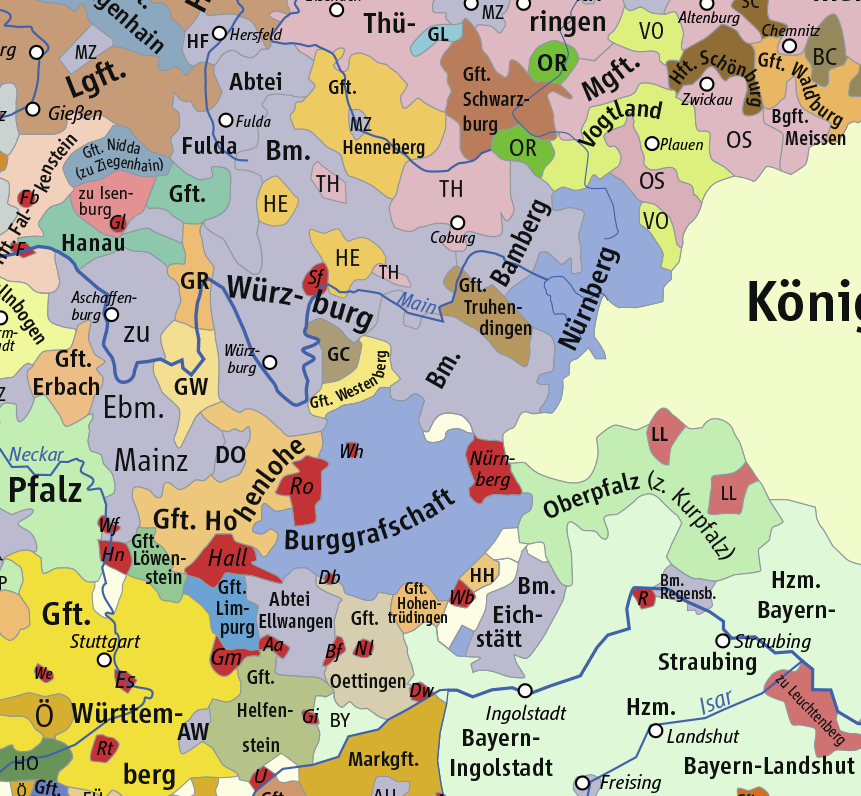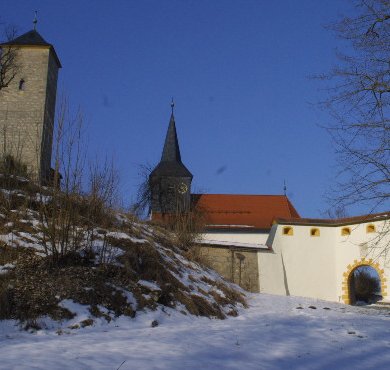|
Ă–lschnitz (White Main)
The Ölschnitz is a right-bank, northern headstream of the White Main in the German province of Upper Franconia in Bavaria. It is long. Course The Ölschnitz has its source at an impoundment and granite well stone in Solg, a village in the borough of Münchberg. It discharges into the White Main near Bad Berneck. The Ölschnitz flows from Solg through a wide valley to the village of Ölschnitz. It then flows down to Tennersreuth, passes under the A 9 motorway, supplies water for the Streitau Mill and continues to Böseneck. From here the little river snakes through an ever-narrower valley. After many bends it reaches the ''Entenmühle'' ("duck mill"), then flows around the hill spur near Stein in a large curve before cutting through the hard, diabase rock in a steep, rocky, narrow valley, rich in flora, and reaching the spa park (''Kurpark'') at Bad Berneck. After almost 19 km it discharges into the White Main. The Ölschnitz valley between the ''Entenmühle'' an ... [...More Info...] [...Related Items...] OR: [Wikipedia] [Google] [Baidu] |
Germany
Germany,, officially the Federal Republic of Germany, is a country in Central Europe. It is the second most populous country in Europe after Russia, and the most populous member state of the European Union. Germany is situated between the Baltic and North seas to the north, and the Alps to the south; it covers an area of , with a population of almost 84 million within its 16 constituent states. Germany borders Denmark to the north, Poland and the Czech Republic to the east, Austria and Switzerland to the south, and France, Luxembourg, Belgium, and the Netherlands to the west. The nation's capital and most populous city is Berlin and its financial centre is Frankfurt; the largest urban area is the Ruhr. Various Germanic tribes have inhabited the northern parts of modern Germany since classical antiquity. A region named Germania was documented before AD 100. In 962, the Kingdom of Germany formed the bulk of the Holy Roman Empire. During the 16th ce ... [...More Info...] [...Related Items...] OR: [Wikipedia] [Google] [Baidu] |
Margrave Of Bayreuth
The Principality of Bayreuth (german: FĂĽrstentum Bayreuth) or Margraviate of Brandenburg-Bayreuth (''Markgraftum Brandenburg-Bayreuth'') was an immediate territory of the Holy Roman Empire, ruled by a Franconian branch of the Hohenzollern dynasty. Since Burgrave Frederick VI of Nuremberg was enfeoffed with the Margraviate of Brandenburg in 1415/17, the Hohenzollern princes transferred the margravial title to their Franconian possessions, though the principality never had been a march. Until 1604 they used Plassenburg Castle in Kulmbach as their residence, hence their territory was officially called the Principality of Kulmbach or Margraviate of Brandenburg-Kulmbach until the Empire's dissolution in 1806. Geography The Kulmbach-Bayreuth principality arose from the northern uplands (''Oberland'') of the former Burgraviate of Nuremberg, while the southern lowlands (''Unterland'') formed the Principality of Ansbach. The final border demarcation was settled by the 1541 House ... [...More Info...] [...Related Items...] OR: [Wikipedia] [Google] [Baidu] |
Bayreuth (district)
Bayreuth () is a ''Landkreis'' (district) in Bavaria, Germany. It surrounds, but does not include the city of Bayreuth. The district is bounded by (from the north and clockwise) the districts of Kulmbach, Hof, Wunsiedel, Tirschenreuth, Neustadt an der Waldnaab, Amberg-Sulzbach, NĂĽrnberger Land, Forchheim and Bamberg. History The district was established in 1972 by merging the former districts of Bayreuth and Pegnitz, adding the town Gefrees of the former district of MĂĽnchberg and the town of Speichersdorf of the former district of Kemnath. Geography The sources of the White Main and the Red Main are both located in the district. The Red Main rises in the very south in the hills of the Frankish Alb, the White Main has its source in the Fichtel Mountains in the east. Both rivers run to the northwest, but do not meet within the district's borders. The valley of the Red Main separates the two major geographical regions of the district from each other: the hilly countryside ... [...More Info...] [...Related Items...] OR: [Wikipedia] [Google] [Baidu] |
Rivers Of Bavaria
A river is a natural flowing watercourse, usually freshwater, flowing towards an ocean, sea, lake or another river. In some cases, a river flows into the ground and becomes dry at the end of its course without reaching another body of water. Small rivers can be referred to using names such as creek, brook, rivulet, and rill. There are no official definitions for the generic term river as applied to geographic features, although in some countries or communities a stream is defined by its size. Many names for small rivers are specific to geographic location; examples are "run" in some parts of the United States, "burn" in Scotland and northeast England, and "beck" in northern England. Sometimes a river is defined as being larger than a creek, but not always: the language is vague. Rivers are part of the water cycle. Water generally collects in a river from precipitation through a drainage basin from surface runoff and other sources such as groundwater recharge, springs, ... [...More Info...] [...Related Items...] OR: [Wikipedia] [Google] [Baidu] |
List Of Rivers Of Bavaria
A list of rivers of Bavaria, Germany: A * Aalbach *Abens * Ach * Afferbach * Affinger Bach * Ailsbach *Aisch * Aiterach *Alpbach *Alster * Altmühl *Alz * Amper * Anlauter * Arbach * Arbachgraben *Aschaff * Aschbach * Attel * Aubach, tributary of the Elsava * Aubach, tributary of the Lohr * Aubach, tributary of the Schwabach * Auer Mühlbach * Auerbach *Aufseß * Aura * Aurach, tributary of the Rednitz * Aurach, tributary of the Regnitz in Middle Franconia * Aurach, tributary of the Regnitz in Upper Franconia * Autenbach B * Bachhaupter Laber * Bächlesbach * Bachmühlbach * Bachquellengraben * Bachwiesengraben *Banzerbach * Baunach *Bayerbacher Bach * Beibuschbach *Berchtesgadener Ache *Bessenbach * Betzenbach * Biber * Biberbach * Bibert * Bina * Blankenbach *Bolgenach * Bösbach *Brandenberger Ache * Braunau *Breitach * Breitbach * Breitenbach * Breitenbrunner Bach * Breitenbrunner Laber * Brend * Brenz * Brombach * Bruchbach * Bruckbach * Brunnbach * Brunnenbach * Brunnthaler ... [...More Info...] [...Related Items...] OR: [Wikipedia] [Google] [Baidu] |
Ă–lschnitz Bad Berneck , headstream of the White Main, Bavaria, Germany
{{geodis ...
Ă–lschnitz may refer to: *Ă–lschnitz (Red Main), headstream of the Red Main, Bavaria, Germany *Ă–lschnitz (White Main) The Ă–lschnitz is a right-bank, northern headstream of the White Main in the German province of Upper Franconia in Bavaria. It is long. Course The Ă–lschnitz has its source at an impoundment and granite well stone in Solg, a village in the b ... [...More Info...] [...Related Items...] OR: [Wikipedia] [Google] [Baidu] |
Gefrees
Gefrees () is a town in the Bayreuth (district), district of Bayreuth, in Bavaria, Germany. It is situated in the Fichtelgebirge, 21 km northeast of Bayreuth. It was the site of a Battle of Gefrees, battle during the Napoleonic Wars. References Bayreuth (district) {{Bayreuthdistrict-geo-stub ... [...More Info...] [...Related Items...] OR: [Wikipedia] [Google] [Baidu] |
Stammbach
Stammbach is a market town and municipality in the district of Hof in Bavaria in Germany Germany,, officially the Federal Republic of Germany, is a country in Central Europe. It is the second most populous country in Europe after Russia, and the most populous member state of the European Union. Germany is situated betwe .... References Hof (district) {{Hofdistrict-geo-stub ... [...More Info...] [...Related Items...] OR: [Wikipedia] [Google] [Baidu] |
Freshwater Pearl Mussel
The freshwater pearl mussel (''Margaritifera margaritifera'') is an endangered species of freshwater mussel, an aquatic bivalve mollusc in the family Margaritiferidae. Although the name "freshwater pearl mussel" is often used for this species, other freshwater mussel species (e.g. ''Margaritifera auricularia'') can also create pearls and some can also be used as a source of mother of pearl. Most cultured pearls today come from ''Hyriopsis'' species in Asia, or ''Amblema'' species in North America, both members of the related family Unionidae; pearls are also found within species in the genus ''Unio''. The interior of the shell of ''Margaritifera margaritifera'' has thick nacre (the inner mother of pearl layer of the shell). This species is capable of making fine-quality pearls, and was historically exploited in the search for pearls from wild sources. In recent times, the Russian malacologist Valeriy Zyuganov received worldwide reputation after he discovered that the pearl m ... [...More Info...] [...Related Items...] OR: [Wikipedia] [Google] [Baidu] |
Diabase
Diabase (), also called dolerite () or microgabbro, is a mafic, holocrystalline, subvolcanic rock equivalent to volcanic basalt or plutonic gabbro. Diabase dikes and sills are typically shallow intrusive bodies and often exhibit fine-grained to aphanitic chilled margins which may contain tachylite (dark mafic glass). ''Diabase'' is the preferred name in North America, while ''dolerite'' is the preferred name in the rest of the English-speaking world, where sometimes the name ''diabase'' refers to altered dolerites and basalts. Some geologists prefer to avoid confusion by using the name ''microgabbro''. The name ''diabase'' comes from the French ', and ultimately from the Greek - meaning "act of crossing over, transition". Petrography Diabase normally has a fine but visible texture of euhedral lath-shaped plagioclase crystals (62%) set in a finer matrix of clinopyroxene, typically augite (20–29%), with minor olivine (3% up to 12% in olivine diabase), magnetite (2%), an ... [...More Info...] [...Related Items...] OR: [Wikipedia] [Google] [Baidu] |
Bavaria
Bavaria ( ; ), officially the Free State of Bavaria (german: Freistaat Bayern, link=no ), is a state in the south-east of Germany. With an area of , Bavaria is the largest German state by land area, comprising roughly a fifth of the total land area of Germany. With over 13 million inhabitants, it is second in population only to North Rhine-Westphalia, but due to its large size its population density is below the German average. Bavaria's main cities are Munich (its capital and largest city and also the third largest city in Germany), Nuremberg, and Augsburg. The history of Bavaria includes its earliest settlement by Iron Age Celtic tribes, followed by the conquests of the Roman Empire in the 1st century BC, when the territory was incorporated into the provinces of Raetia and Noricum. It became the Duchy of Bavaria (a stem duchy) in the 6th century AD following the collapse of the Western Roman Empire. It was later incorporated into the Holy Roman Empire, became an ind ... [...More Info...] [...Related Items...] OR: [Wikipedia] [Google] [Baidu] |
Bundesautobahn 9
is an autobahn in Germany, connecting Berlin and Munich via Leipzig and Nuremberg. It is the fifth longest autobahn spanning . Route The northern terminus of the A 9 is at the Potsdam interchange, where it merges into the A 10, also known as the "''Berliner Ring''", about away from the Berlin city limits. The shortest route from there into Berlin would be the A 10 (east) and the A 115 (AVUS). The southern end is in the Munich borough of Schwabing. On its way, the A 9 passes through the German states of Brandenburg, Saxony-Anhalt, Thuringia, and Bavaria. West of Leipzig, the border between Saxony-Anhalt and Saxony crisscrosses along the autobahn. In Bavaria, long sections of the Nuremberg–Munich high-speed railway run parallel to the autobahn. History Plans for a European motorway connection from Berlin to Rome were already developed from 1927 by a private ''MüLeiBerl'' (Munich-Leipzig-Berlin) company. However, construction of the A 9 wa ... [...More Info...] [...Related Items...] OR: [Wikipedia] [Google] [Baidu] |





